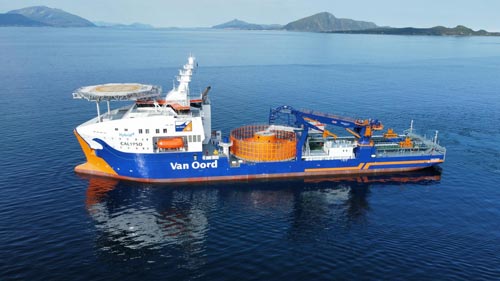Cable Lay Vessels: Navigating the Depths to Connect the World

A Cable Lay Vessel (CLV) is a specialized type of offshore vessel used to lay submarine cables on the seabed. These cables can be for various purposes, including telecommunications, power transmission (such as offshore wind farm cables), and oil & gas projects (such as subsea umbilicals and pipeline connections). The primary role of a cable lay vessel is to transport, lay, and sometimes bury these cables on the ocean floor, often in deep or challenging conditions.
Key Features of a Cable Lay Vessel:
Cable Storage and Handling:
CLVs are equipped with large cable reels or cable tanks where long lengths of cable are stored. The vessel can carry thousands of tons of cable, depending on the project and the type of cable being laid.
Cable tensioners and turning devices are used to ensure that the cable is fed smoothly and without excessive strain onto the seabed.
Cable Lay System:
The cable lay system on these vessels is designed to deploy cables in a controlled manner to avoid damage to the cable. The system usually includes a plough or trenching machine that helps to bury the cable beneath the seabed to protect it from external forces (like fishing activities or anchor dragging).
Dynamic positioning (DP) systems are commonly used to ensure that the vessel stays in a precise location while laying the cable, especially in deepwater or where the seabed is uneven.
Types of Cables Laid:
Telecommunications cables:
These are used for global communication networks, including internet and telephone connections that are laid across oceans.
Power cables:
These are used to transmit electrical power from offshore wind farms, oil and gas platforms, or between different regions (such as undersea power transmission lines).
Subsea umbilicals and pipeline cables:
These cables are used for various subsea operations, providing power, control, and communication to offshore oil rigs, platforms, and other installations.
Dynamic Positioning (DP):
Many modern cable lay vessels are equipped with Dynamic Positioning (DP) systems, allowing them to stay on station without the need for anchors. This is especially important for cable laying in deeper waters or in areas with challenging environmental conditions.
DP2 vessels have additional redundancies in their DP systems for extra safety and reliability.
Deck Space and Equipment:
A CLV is designed with ample deck space to accommodate the large reels of cable and specialized machinery needed for cable laying. It also often includes cranes and winches for handling heavy equipment or assisting with the cable laying process.
Cable protection devices, such as ploughs, are used to bury cables into the seabed for protection, particularly in areas with heavy shipping traffic or fishing activities.
Multifunctionality:
Some cable lay vessels are equipped to perform both cable laying and ROV (Remotely Operated Vehicle) operations. ROVs are used to inspect the laying process, ensure proper cable placement, and troubleshoot any issues during cable installation.
Accommodations:
Like many offshore vessels, CLVs provide living accommodations for the crew, engineers, and other personnel involved in the cable laying operations. These can include cabins, mess rooms, and workspaces.
Use in Renewable Energy:
Cable lay vessels are critical for offshore wind farms, where they are used to lay the underwater cables that connect wind turbines to the electrical grid. As renewable energy projects expand, the demand for these vessels is growing.
Size and Capacity:
Cable lay vessels come in a range of sizes, from relatively small vessels suitable for shallow waters to large, heavy-duty vessels designed for deep-water projects. The size of the vessel and its cable storage capacity depends on the scale of the project and the specific requirements of the cable being laid.
A Cable Lay Vessel (CLV) is a specialized offshore vessel used for laying submarine cables for telecommunications, power transmission, and subsea oil and gas operations. These vessels are equipped with advanced cable handling and laying systems, dynamic positioning technology, and other tools that enable them to work efficiently and safely in challenging offshore environments, including deepwater and harsh weather conditions. CLVs are essential for the construction of global communication networks, renewable energy infrastructure like offshore wind farms, and the oil and gas industry.
Search Jobs
Seagoing Jobs
- Deck Officer Jobs (41)
- Deck Rating Jobs (7)
- Engineering Officer Jobs (71)
- Engineering Rating Jobs (1)
- Catering Rating Jobs (5)
- Specialist Jobs (3)
- Other Maritime Jobs (38)
Shore Side Jobs
- Shore Side Jobs (15)
Offshore Jobs
- Offshore Jobs (4)
- Drilling / Rig Jobs (0)
- ROV/Diving Jobs (0)
- Production Jobs (0)
- Oilfield Services Jobs (0)
- Procurement & Construction Jobs (0)
- Engineering & Science Jobs (0)
- Geosciences Jobs (0)
- Maintenance & Inspection Jobs (0)
- Health, Safety & Environment Jobs (1)
- Refining & Petrochem Jobs (0)
- Business, IT, HR & Admin Jobs (0)
- Trades & Technicians Jobs (1)
- Other Offshore Jobs (0)

Share this page: